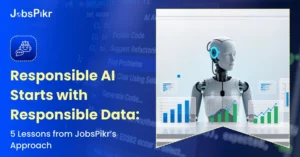Hiring has always been an uphill task. According to the U.S. Department of Labor, the true cost of a bad hire is at least 30 percent of the employee’s earning in the first year. A couple of summers back, Amazon had roughly 50,000 open positions they were looking to hire for. To fill in this tremendous demand-supply gap, they created something called an Amazon Jobs Day: a one-day job fair hosted across America where their recruiters gave on-the-spot jobs to successful candidates.
Well, Amazon can do that. But not everybody can churn out that kind of money and entice that kind of reaction. High volume recruiting, hence, will always be a huge challenge for big and small companies alike. Especially in an industry where the supply always surpasses the demand. One open application and you get hundreds of thousands of applications. Imagine dealing with 50000. While there are no definite figures as to what precisely stands for high volume, some research suggests ~250 open positions denote mass recruiting. In general, it is mainly needed when a business grows exponentially, or when expanding into a new space or revenue stream.

1. Candidate Sourcing
First things first, sourcing the right candidates is the first important step. In order to attract the best talents, you have to make sure that your job opening is accessible to them. This is where technology comes in. Especially if it is mass recruiting. Automation can help you source the right candidates, so you’re working with a talented pool of applicants from the start.
There are a variety of ways you can make this happen:
A). Job scraping
Job scraping service providers, driven by algorithms, crawl the web and look for vacant jobs including the career sites of all companies and all other job sites, and consolidates it in one place. The job scraping service providers. These tools crawl all across the internet to dig and harvest job data to make it easy for job-seekers to locate you.
B). Programmatic Advertising
Programmatic advertising is a recruitment marketing strategy. This involves taking part in the bid-based marketplace, so as to advertise your requirements in a more cost-efficient manner.
Unlike traditional digital advertising, this uses predetermined rules and insights to help drive purchase decisions. This helps you advertise the right thing to the right people at the right time.
C). Chatbots
Chatbots are one of the primary drivers of customer service and client communication. This is why they translate into recruiting so seamlessly. They can easily take over some of the more time-consuming tasks at the first level: vetting and screening of new applicants. For example, it can find out if the applicant has the minimum number of work experience required. It is that easy.
2. Optimize Your Job Page to facilitate search
Your career page has to be search engine optimized. It has to appear on the first page of Google for relevant search strings. Study your competitors. See what keywords they are ranking for. SEO is not just a marketing vertical anymore. It will also propel your career pages and help gain visibility and conversions thereby. Also, while attracting top talent, just basic job descriptions won’t help. You have to talk about the job value proposition you’re offering. Especially if you have to attract multiple talents for multiple positions, you have lubricated the process of them seeking you out as much as you seek them out.
Artificial Intelligence tools like the TapRecruit Smart Editor can help make your job descriptions come to life, be more inclusive and appealing, and optimized for search. This also reduces the bounce rate from your career site. Tracking where you are losing the candidate’s interest will help you rework the UX/UI of your job page. These are also the main contributor to high volume recruiting.
3. Candidate screening
For high volume recruiting, it becomes that much more difficult to weed out the perfect candidate for each opening. It can get quite overwhelming when you have thousands of applicants and qualified candidates to choose from. Not to mention that it becomes increasingly difficult to remove biases, especially while screening a billion CVs. The right automation and Artificial Intelligence tool can make the screening as objective as possible. You can use an automated pre-employment assessment software, to screen through as many applications as possible and give all of them a fair and equal chance.
4. Candidate Tracking
There are different tools, apps, and tech-based job scraping service processes that help at every step of the recruitment funnel – right from sourcing to onboarding. Helping you pick up the slack where you need it most. And the one place where recruiters lose momentum is candidate tracking.
You have to use the Applicant Tracking System (ATS), which is an absolutely indispensable component of staying at top of your high-volume recruitment process. ATS keeps the thousands of applications, paperwork and documents in one place of each candidate. In fact, they also help you see which applicants are the best matches for your open position.
In fact, other document automation systems, can also help your recruitment team in sending out forms, collecting feedback, and keeping them in one place for you in a formatted manner. Everything for you will be a click away, whether you have one open position or a thousand.
5. Candidate Onboarding
This is the last leg of the funnel is candidate onboarding. You have now recruited the best talent possible. The next step is training is orientation and making them feel like a major part of the community.
Typically, when hiring in larger volumes, you can’t use the same onboarding strategies you will use for bringing in a couple of new hires. Well, technology to the rescue again.
Onboarding software creates a cohesive and granular roadmap for bringing in your new hires and being cost-efficient at the same time. By using similar services, new employees can comb through modules, connect with peers, and get trained on the go.
The Future of Technology and Mass Recruiting
Technology will be making our lives simpler by the minute every breathing minute. The onus is on us to embrace and leverage it. Especially where volume is concerned. If you are hesitant to automate the entire process in one go, evaluate the areas where you struggle the most and automate that. One step at a time. The journey is worth it. Trust us.
If you liked reading this as much as we enjoyed writing this, please share the love. We think you might enjoy reading The Top Trends Revolutionizing The Recruitment Technology.




